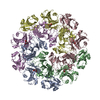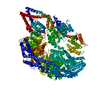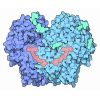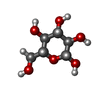+ Open data
Open data
- Basic information
Basic information
| Entry | Database: PDB / ID: 7ptu | ||||||||||||
|---|---|---|---|---|---|---|---|---|---|---|---|---|---|
| Title | Structure of pentameric S-layer protein from Halofaerax volcanii | ||||||||||||
 Components Components | Cell surface glycoprotein | ||||||||||||
 Keywords Keywords | STRUCTURAL PROTEIN / S-layer csg | ||||||||||||
| Function / homology |  Function and homology information Function and homology informationS-layer / cell wall organization / extracellular region / plasma membrane Similarity search - Function | ||||||||||||
| Biological species |  Haloferax volcanii DS2 (archaea) Haloferax volcanii DS2 (archaea) | ||||||||||||
| Method | ELECTRON MICROSCOPY / single particle reconstruction / cryo EM / Resolution: 3.87 Å | ||||||||||||
 Authors Authors | von Kuegelgen, A. / Bharat, T.A.M. | ||||||||||||
| Funding support |  United Kingdom, 3items United Kingdom, 3items
| ||||||||||||
 Citation Citation |  Journal: Cell Rep / Year: 2021 Journal: Cell Rep / Year: 2021Title: Complete atomic structure of a native archaeal cell surface. Authors: Andriko von Kügelgen / Vikram Alva / Tanmay A M Bharat /   Abstract: Many prokaryotic cells are covered by an ordered, proteinaceous, sheet-like structure called a surface layer (S-layer). S-layer proteins (SLPs) are usually the highest copy number macromolecules in ...Many prokaryotic cells are covered by an ordered, proteinaceous, sheet-like structure called a surface layer (S-layer). S-layer proteins (SLPs) are usually the highest copy number macromolecules in prokaryotes, playing critical roles in cellular physiology such as blocking predators, scaffolding membranes, and facilitating environmental interactions. Using electron cryomicroscopy of two-dimensional sheets, we report the atomic structure of the S-layer from the archaeal model organism Haloferax volcanii. This S-layer consists of a hexagonal array of tightly interacting immunoglobulin-like domains, which are also found in SLPs across several classes of archaea. Cellular tomography reveal that the S-layer is nearly continuous on the cell surface, completed by pentameric defects in the hexagonal lattice. We further report the atomic structure of the SLP pentamer, which shows markedly different relative arrangements of SLP domains needed to complete the S-layer. Our structural data provide a framework for understanding cell surfaces of archaea at the atomic level. | ||||||||||||
| History |
|
- Structure visualization
Structure visualization
| Movie |
 Movie viewer Movie viewer |
|---|---|
| Structure viewer | Molecule:  Molmil Molmil Jmol/JSmol Jmol/JSmol |
- Downloads & links
Downloads & links
- Download
Download
| PDBx/mmCIF format |  7ptu.cif.gz 7ptu.cif.gz | 395.9 KB | Display |  PDBx/mmCIF format PDBx/mmCIF format |
|---|---|---|---|---|
| PDB format |  pdb7ptu.ent.gz pdb7ptu.ent.gz | 315.2 KB | Display |  PDB format PDB format |
| PDBx/mmJSON format |  7ptu.json.gz 7ptu.json.gz | Tree view |  PDBx/mmJSON format PDBx/mmJSON format | |
| Others |  Other downloads Other downloads |
-Validation report
| Arichive directory |  https://data.pdbj.org/pub/pdb/validation_reports/pt/7ptu https://data.pdbj.org/pub/pdb/validation_reports/pt/7ptu ftp://data.pdbj.org/pub/pdb/validation_reports/pt/7ptu ftp://data.pdbj.org/pub/pdb/validation_reports/pt/7ptu | HTTPS FTP |
|---|
-Related structure data
| Related structure data |  13638MC  7ptpC  7ptrC  7pttC M: map data used to model this data C: citing same article ( |
|---|---|
| Similar structure data |
- Links
Links
- Assembly
Assembly
| Deposited unit | 
|
|---|---|
| 1 |
|
- Components
Components
| #1: Protein | Mass: 81755.602 Da / Num. of mol.: 5 / Source method: isolated from a natural source / Source: (natural)  Haloferax volcanii DS2 (archaea) / Plasmid details: Allers et al 2004 / References: UniProt: P25062 Haloferax volcanii DS2 (archaea) / Plasmid details: Allers et al 2004 / References: UniProt: P25062#2: Sugar | ChemComp-BGC / Has ligand of interest | Y | Has protein modification | Y | |
|---|
-Experimental details
-Experiment
| Experiment | Method: ELECTRON MICROSCOPY |
|---|---|
| EM experiment | Aggregation state: PARTICLE / 3D reconstruction method: single particle reconstruction |
- Sample preparation
Sample preparation
| Component | Name: Structure of pentameric S-layer protein csg / Type: COMPLEX / Details: Structure of pentameric S-layer protein csg / Entity ID: #1 / Source: NATURAL | |||||||||||||||||||||||||
|---|---|---|---|---|---|---|---|---|---|---|---|---|---|---|---|---|---|---|---|---|---|---|---|---|---|---|
| Molecular weight | Experimental value: NO | |||||||||||||||||||||||||
| Source (natural) | Organism:  Haloferax volcanii DS2 (archaea) / Cellular location: Cell surface Haloferax volcanii DS2 (archaea) / Cellular location: Cell surface | |||||||||||||||||||||||||
| Buffer solution | pH: 7.5 Details: Buffer solutions were prepared fresh from sterile filtered concentrated stocksolutions. Solutions were filtered through a 0.22 um filter to avoid microbial contamination and degassed using a ...Details: Buffer solutions were prepared fresh from sterile filtered concentrated stocksolutions. Solutions were filtered through a 0.22 um filter to avoid microbial contamination and degassed using a vacuum fold pump. The pH of the HEPES stock solution was adjusted with sodium hydroxide at 4 deg C. 1.75 mM holmium chloride was added 2 hours before vitrification. | |||||||||||||||||||||||||
| Buffer component |
| |||||||||||||||||||||||||
| Specimen | Conc.: 2.5 mg/ml / Embedding applied: NO / Shadowing applied: NO / Staining applied: NO / Vitrification applied: YES Details: Purified csg protein mixed with 1.75 mM HoCl3 after 2 hour incubation. | |||||||||||||||||||||||||
| Specimen support | Details: 20 seconds, 15 mA / Grid material: COPPER/RHODIUM / Grid mesh size: 200 divisions/in. / Grid type: Quantifoil R2/2 | |||||||||||||||||||||||||
| Vitrification | Instrument: FEI VITROBOT MARK IV / Cryogen name: ETHANE / Humidity: 100 % / Chamber temperature: 283.15 K Details: Vitrobot options: Blot time 5 seconds, Blot force -10,1, Wait time 10 seconds, Drain time 0.5 seconds |
- Electron microscopy imaging
Electron microscopy imaging
| Experimental equipment |  Model: Titan Krios / Image courtesy: FEI Company |
|---|---|
| Microscopy | Model: FEI TITAN KRIOS Details: EPU software with faster acquisition mode AFIS (Aberration Free Image Shift). |
| Electron gun | Electron source:  FIELD EMISSION GUN / Accelerating voltage: 300 kV / Illumination mode: FLOOD BEAM FIELD EMISSION GUN / Accelerating voltage: 300 kV / Illumination mode: FLOOD BEAM |
| Electron lens | Mode: BRIGHT FIELD / Nominal magnification: 81000 X / Calibrated magnification: 81000 X / Nominal defocus max: 4000 nm / Nominal defocus min: 1000 nm / Calibrated defocus min: 1000 nm / Calibrated defocus max: 4000 nm / Cs: 2.7 mm / C2 aperture diameter: 50 µm / Alignment procedure: ZEMLIN TABLEAU |
| Specimen holder | Cryogen: NITROGEN / Specimen holder model: FEI TITAN KRIOS AUTOGRID HOLDER / Temperature (max): 70 K / Temperature (min): 70 K |
| Image recording | Average exposure time: 3.6 sec. / Electron dose: 53.9 e/Å2 / Film or detector model: GATAN K3 BIOQUANTUM (6k x 4k) / Num. of grids imaged: 2 / Num. of real images: 11871 Details: Images were collected in two sessions in movie-mode and subjected to 3.6 seconds of exposure where a total dose of 53.45 or 53.9 e-/A2 was applied, and 40 frames were recorded per movie. A ...Details: Images were collected in two sessions in movie-mode and subjected to 3.6 seconds of exposure where a total dose of 53.45 or 53.9 e-/A2 was applied, and 40 frames were recorded per movie. A total of 11871 movies were collected in two sessions with the same microscope and settings. |
| EM imaging optics | Energyfilter name: GIF Quantum LS / Energyfilter slit width: 20 eV |
| Image scans | Width: 5760 / Height: 4092 |
- Processing
Processing
| Software | Name: PHENIX / Version: 1.19_4092: / Classification: refinement | ||||||||||||||||||||||||||||||||||||||||||||||||||
|---|---|---|---|---|---|---|---|---|---|---|---|---|---|---|---|---|---|---|---|---|---|---|---|---|---|---|---|---|---|---|---|---|---|---|---|---|---|---|---|---|---|---|---|---|---|---|---|---|---|---|---|
| EM software |
| ||||||||||||||||||||||||||||||||||||||||||||||||||
| Image processing | Details: Imported movies were motion-corrected, dose weighted, and Fourier cropped (2x) with MotionCor2 (Zheng et al., 2017) implemented in RELION3.1 (Zivanov et al., 2018). Contrast transfer ...Details: Imported movies were motion-corrected, dose weighted, and Fourier cropped (2x) with MotionCor2 (Zheng et al., 2017) implemented in RELION3.1 (Zivanov et al., 2018). Contrast transfer functions (CTFs) of the resulting motion-corrected micrographs were estimated using CTFFIND4 (Rohou and Grigorieff, 2015). | ||||||||||||||||||||||||||||||||||||||||||||||||||
| CTF correction | Details: RELION refinement with in-built CTF correction. The function is similar to a Wiener filter, so amplitude correction included. Type: PHASE FLIPPING AND AMPLITUDE CORRECTION | ||||||||||||||||||||||||||||||||||||||||||||||||||
| Particle selection | Num. of particles selected: 1773652 Details: Particles were initially picking using the Laplacian-of gaussian algorithm implemented in RELION3.0 (Zivanov et al., 2018). Particles were extracted in 8x down-sampled in 50x50 pixel boxes ...Details: Particles were initially picking using the Laplacian-of gaussian algorithm implemented in RELION3.0 (Zivanov et al., 2018). Particles were extracted in 8x down-sampled in 50x50 pixel boxes and classified using reference-free 2D classification inside RELION3.0. | ||||||||||||||||||||||||||||||||||||||||||||||||||
| Symmetry | Point symmetry: C5 (5 fold cyclic) | ||||||||||||||||||||||||||||||||||||||||||||||||||
| 3D reconstruction | Resolution: 3.87 Å / Resolution method: FSC 0.143 CUT-OFF / Num. of particles: 382105 / Algorithm: FOURIER SPACE Details: The final map (RELION3.1) was obtained from 382,105 particles and post-processed using a soft mask focused on the entire pentameric map yielding a global resolution of 3.87 angstrom with ...Details: The final map (RELION3.1) was obtained from 382,105 particles and post-processed using a soft mask focused on the entire pentameric map yielding a global resolution of 3.87 angstrom with resolution anisotropy from 3.49-8.11 angstrom from the central C5 axis near domains D1-D3 (well resolved) to the more flexible domains D4 (partially resolved) and D5-D6 (not resolved). Num. of class averages: 3 / Symmetry type: POINT | ||||||||||||||||||||||||||||||||||||||||||||||||||
| Atomic model building | B value: 179.68 / Protocol: AB INITIO MODEL / Space: REAL / Target criteria: Best Fit Details: The initial manual build of D1-D2 was performed independently using the csg pentameric cryo-EM map, which served as an additional validation of the manual building performed in the csg ...Details: The initial manual build of D1-D2 was performed independently using the csg pentameric cryo-EM map, which served as an additional validation of the manual building performed in the csg hexamer in the related deposition. The manual building exercise yielded a nearly identical result to the hexamer; thus, the final refined hexameric structures of D1-D2, along with D3-D4 were taken and fitted into the pentameric map (~3.87 angstrom resolution in D1-D3, lower in D4 which is partially resolved). Five copies of these D1-D4 were used for refinement and model building as for the hexamer, except D3 and D4 was restrained in position, due to steadily deteriorating resolution in this part of the map. D5-D6 were not resolved in the pentameric structure and were thus not included in the refinements. Model validation was performed in PHENIX and CCP-EM. |
 Movie
Movie Controller
Controller













 PDBj
PDBj




